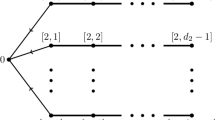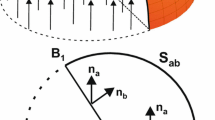Abstract
We study positive operator-valued measures generated by projections on one-dimensional subspaces. A special attention is paid to the case in which subspaces are spanned by vectors forming a Riesz basis. It is shown that the measurement fulfilled by such measure is informationally complete for quantum states being a convex hull of projections on subspaces spanned by the system of biorthogonal vectors. We also discuss the properties of different quantum channels associated with a discrete measurement. Finally, we show that our measurement allows to introduce a quantum instrument taking values in the set of two points.
Similar content being viewed by others
Data availability statement
Data sharing is not applicable to this article as no new data were created or analyzed in this study.
References
Alekseev, A.O., Amosov, G.G.: On restoring a quantum state after the measurement. Lobachevskii J. Math. 44(6), 1974–1979 (2023)
Alekseev, A.O., Amosov, G.G.: On extension of the family of projections to positive operator-valued measure. Vestn. St. Petersbg. Univ. Math. 56(1), 1–8 (2023)
Amosov, G.G., Mancini, S., Man’ko, V.I.: On the information completeness of quantum tomograms. Phys. Lett. A 372(16), 2820–2824 (2008)
Appleby, D.M.: Symmetric informationally complete-positive operator valued measures and the extended Clifford group. J. Math. Phys. 46, 052107 (2005)
Busch, P.: Informationally complete sets of physical quantities. Int. J. Theor. Phys. 30, 1217 (1991)
Casazza, P.G.: The art of frame theory. Taiwan. J. Math. 4(2), 129–201 (2000)
D’Ariano, G.M., Perinotti, P., Sacchi, M.F.: Informationally complete measurements and group representation. J. Opt. B Quant. Semiclass. Opt. 6(6), S487 (2004)
Davies, E.B., Lewis, J.T.: An operational approach to quantum probability. Commun. Math. Phys. 17, 239–260 (1970)
Durt, T., Englert, B.-G., Bengtsson, I., Zyczkowski, K.: On mutually unbiased bases. Int. J. Quant. Inf. 8, 535–640 (2010)
Helstrom, C.W.: Quantum detection and discrimination theory. J. Stat. Phys. 1, 231–252 (1969)
Holevo, A.S.: On complementary channels and the additivity problem. Probab. Theory Appl. 51, 133–143 (2005)
Holevo, A.: Probabilistic and Statistical Aspects of Quantum Theory. Publications of the Scuola Normale Superiore, Pisa (2011)
Holevo, A.S.: Quantum System, Channels, Information. De Gruyter, Berlin (2013)
Holevo, A.: On the classical capacity of general quantum Gaussian measurement. Entropy 23(3), 377 (2021)
Ivanovic, I.D.: How to differentiate between non-orthogonal states. Phys. Lett. A 126(6), 257–259 (1987)
Kronberg, D.A.: Increasing the distinguishability of quantum states with an arbitrary success probability. Proc. Steklov Inst. Math. 313, 113–119 (2021)
Kronberg, D.A.: Modification of quantum measurements by mapping onto quantum states and classical outcomes. Lobachevskii J. Math. 43(7), 1663–1668 (2022)
Marcus, A.W., Spielman, D.A., Srivastava, N.: Interlacing families II: mixed characteristic polynomials and the Kadison–Singer problem. Ann. Math. 182(1), 327–350 (2015)
Peres, A.: How to differentiate between non-orthogonal states. Phys. Lett. A 128(1–2), 19 (1988)
Prugovecki, E.: Information-theoretical aspects of quantum measurement. Int. J. Theor. Phys. 16, 321 (1977)
Renes, J.M., Blume-Kohout, R., Scott, A.J., Caves, C.M.: Symmetric informationally complete quantum measurements. J. Math. Phys. 45(6), 2171–2180 (2004)
Schroek, F.E.: Quantum Mechanics on Phase Space. Kluwer, Dordrecht (1996)
Acknowledgements
The work of G.G. Amosov was performed at the Steklov International Mathematical Center and supported by the Ministry of Science and Higher Education of the Russian Federation (agreement no. 075-15-2022-265).
Author information
Authors and Affiliations
Corresponding author
Additional information
Communicated by Airat Bikchentaev.
Rights and permissions
Springer Nature or its licensor (e.g. a society or other partner) holds exclusive rights to this article under a publishing agreement with the author(s) or other rightsholder(s); author self-archiving of the accepted manuscript version of this article is solely governed by the terms of such publishing agreement and applicable law.
About this article
Cite this article
Amosov, G.G., Baranov, A.D. & Kronberg, D.A. On positive operator-valued measures generated by a family of one-dimensional projectors. Ann. Funct. Anal. 15, 48 (2024). https://doi.org/10.1007/s43034-024-00351-y
Received:
Accepted:
Published:
DOI: https://doi.org/10.1007/s43034-024-00351-y




